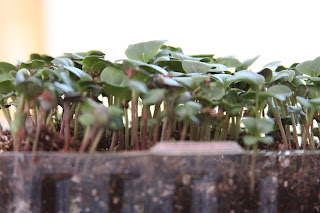Microgreens - grow them at home
Microgreens are vegetable and herb seeds grown in water or in soil and harvested when there are only one or two sets of leaves.
Baby greens, sold as bagged baby green salad or mesclun are essentially the same thing but grown another few weeks until the leaves are larger.
In order to have a pot full of microgreens, the seeds are sown close together. Planted that way, the seedlings grow tall and straight with a tender stem and bright-colored leaves.
The attraction of microgreens is
their nutritional value. Some, such as broccoli, flax, beets, mustard, chia and
wheat grass are grown for specific healing properties. Others, such as
sunflowers, corn and pea shoots are grown as nutritious garnishes for the restaurant
industry.
The vitamin and mineral values of microgreens is concentrated. WebMd says they are 40-times more nutrient dense than full-size lettuce, cabbage, and other green vegetable leaves.
Sharon Owen, owner of Moonshadow Herb Farm, grows microgreens to sell at the Muskogee Farmers Market. She said, “A lot of people grow them on a sunny porch or deck if they live in a temperate climates. I grow them under lights, in a controlled environment that is very clean, so there is little chance of anything going wrong.
Here are the basics of growing microgreens at home in containers -
*Find a warm place where containers will receive a minimum of 4 hours of sunlight or bright artificial light.
*Select containers that are 2-inches deep (recycled yogurt containers, etc.)
If you have a clear plastic berry or lettuce box (clamshell), line it with a coffee filter.
Microgreen growing mats are also available (www.growingmicrogreens.com).
*Fill containers with soil-less planting mix and lightly press soil to firm.
*Scatter seeds 1/4 inch apart.
 |
| Microgreens - radishes under lights after 5 days |
 |
| Microgreen roots - grown in strawberry clamshell |
*For a continuous supply, snip the plants above the first set of leaves and allow them to grow longer, or plant fresh seeds every 7 to 10 days.
*After harvesting microgreens, discard soil and seeds, sterilize the containers, and begin again.
Some popular microgreens include: Arugula, basil, radish, peas, chives, red cabbage, watercress, kale, and lettuce.
 |
| Jalene Riley - Utopia Gardens |
Until gardening season begins in April, you can bring nutrition and fresh flavors to your table and lunch box with homegrown microgreens.
There is a good tutorial with helpful step-by-step illustrations at http://bit.ly/XeRNag.
Growing Microgreens (www.growingmicrogreens.com) has kits that cost $30 to $90.
SproutPeople (http://sproutpeople.org) sells seeds; their "Sprout School" link is informative.
For visual learners, Benjamin Carroll of the Chicago Botanic Garden has a video at
http://www.youtube.com/watch?v=9h1ADMsKQTg.
Companies such as Johnny's Seeds and High Mowing Seeds sell microgreen and sprouting seeds and many can be purchased locally.
For more instructions and resources visit Mark Braunstein’s website at www.markbraunstein.org/growmicrogreens.htm.



Comments